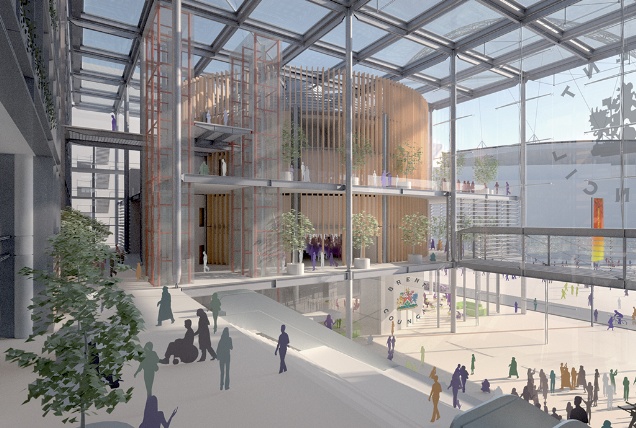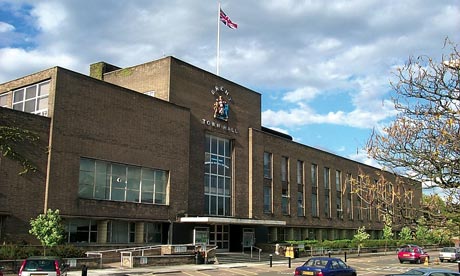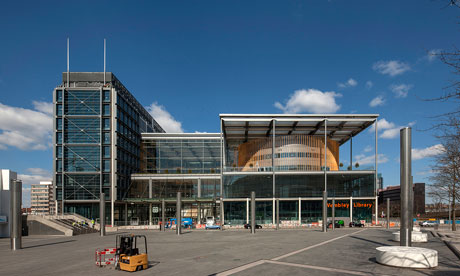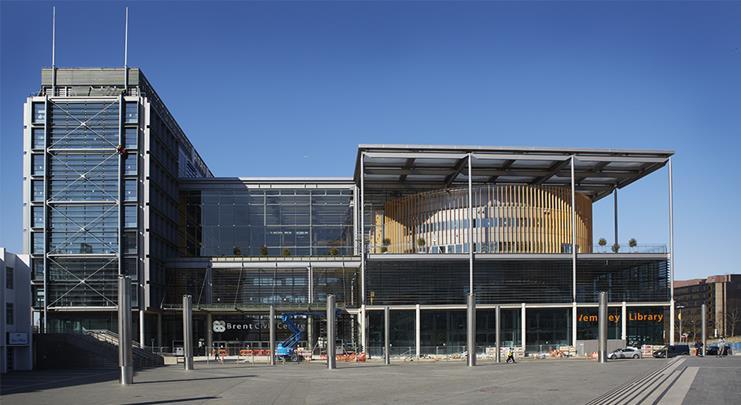Due to the Banker's crisis there have been very few major public capital project schemes. EDDC it would appear seems to be strangely recession proof, perhaps the just-completed £90M Brent Civic Centre by Wembly Stadium is what they have in mind.
Hopkins' Brent civic centre opens
Hopkins Architects’ new Brent Civic Centre in north-west London was officially opened last weekend.
The centre includes the new Wembley library and opened its doors earlier this summer.
Standing in the shadow of Wembley stadium, the building houses the council’s civic, public and administrative functions under one roof and provides space for 2,000 staff.

The atrium acts as the main visitor entrance for the civic centre. All of the slimline steelwork is visible and is an important aesthetic element of the 31m-high structure.
Brent Council leader Muhammed Butt said: “The event was about bringing people together to celebrate this fantastic, state-of-the-art building.”
The project has been given a Breeam ‘Outstanding’ rating and is the first project in its category to have achieved this.
 Brent celebrates the grand opening of your civic centre.
Brent celebrates the grand opening of your civic centre.
A free event for Brent's diverse community
Brent Civic Centre, Engineers Way, Wembley, HA9 0FJ
Come along and enjoy fantastic free activities including sports, art exhibitions, craft workshops, musical performances and venue tours at this exciting launch event.
Brent council's new £90m civic centre seen as machine for making money
Centre designed to bring council functions under one roof – and as a clever sequence of money-making possibilities
At a time when local authorities are being forced to make cuts, it might seem strange for Brent, the most deprived borough in west London, to be unveiling a new £90m council headquarters. But the gleaming new civic centre, which stands in the shadow of Wembley stadium, is no ordinary council office. Designed by Hopkins, architects of the palatial Portcullis House at Westminster, it is conceived as a 21st-century machine for delivering public services – and making money.
Bringing together every council department of one of London's largest boroughs – currently housed in 14 buildings scattered across the area – it combines the functions of a town hall and conference centre, wedding venue and public library, cafe and "customer service centre". Before its opening, it has been declared the most sustainable public building in the UK, complete with a boiler that runs on fish oil.
Brent council's new £90m civic centre seen as machine for making money | Art and design | The Guardian
How more flexible working can drive tech innovation
Brent council hopes that enabling more employees to work remotely will decrease costs and create a more tech-savvy workforce

Brent Town Hall, which is one of 14 buildings to be consolidated into a new civic centre.
Brent council has introduced remote working for most employees in a bid to cut the cost of office space and improve productivity.
The programme began two years ago with a plan to cut the financial drain of unused desk space by condensing the council's 14 buildings into a new civic centre. Brent's chief information officer Stephan Conaway explained that the council decided to implement remote working for the majority of employees ahead of the move to the new headquarters, which will open in summer 2013, as this could enable staff such as environmental inspectors and social workers who often work "on the road" to operate more efficiently.
By enabling staff to file reports, sign forms and undertake other administrative tasks via mobile phones, laptops and tablets, the council hopes to decrease time spent in transit and increase productivity.
How more flexible working can drive tech innovation | Public Leaders Network | Guardian Professional
How can cross sector partnerships drive sustainable development?
Economic development should be underpinned by low-carbon, climate resilient growth, while protecting the communities and markets in which business operates
Sponsored feature
Sponsored feature

The Brent Civic Centre, in north-west London, is an example of how civil society, government and the private sector can work together to produce sustainable development outcomes. Photograph: Morley
Companies and governments now realise urban development, from new housing and office complexes to transportation projects, requires collaboration, not conflict, between the private, public and third sectors. The spectre of climate change, energy security issues and water scarcity calls for the private sector, government and civil society to work together to mitigate those risks in the communities in which they operate.
Across the world, as the global population booms and consumes even more materials in the next several years, it is clear one stakeholder group cannot confront these challenges alone. While companies struggle to build more resilient supply chains, the public sector has the task of providing a safe infrastructure so businesses can continue to thrive; and civil society must ensure the planet's resources and people are treated fairly and equitably.
It is possible to create a business environment in which sustainable and low-carbon growth are not only feasible, but necessary in a world with constrained resources, says Robert Spencer, business line director of sustainability at URS.
"The companies that will do well in the next five, 10, 15 years," Spencer says, "are the ones who have 'future proofed' themselves in a world that will see more extreme weather events and less energy security."
Those same companies will be in a stronger position to design and build the new infrastructure systems governments are desperate to provide their citizens.
Both the private and public sectors have long been guilty of a linear approach towards development and economic growth. A dismissive view of waste, excessive water consumption and environmental degradation were, for example, the byproducts of construction projects. Instead, explains Spencer, a circular economy, with a view towards development as an ecosystem, is necessary to instil a smarter use of resources.
The UK model of public-private partnerships (PPPs), a key facet of the current administration's plan for sustainable development, has experienced its share of growing pains. But PPPs are a leading example of how society can bridge the worldwide estimated $3trn (£1.94trn) gap in needed infrastructure projects while managing careful stewardship of the world's diminishing resources.
To that end, the UK's National Industrial Symbiosis Programme (Nisp)demonstrates how government and business can work together to help industry cut costs associated with waste, transportation and storage. The Nisp network includes both large multinationals and small local businesses seeking new markets for unwanted materials that otherwise would end up in landfill.
"NISP demonstrates that PPPs can work exceptionally well," explains Peter Laybourn, chief executive of International Synergies, the company that created Nisp. "In eight years Nisp has saved UK businesses over £1bn as well as reducing CO2 by 42m tonnes."
Another success story is the Wallasea Island Wild Coast Project in Essex, a partnership between the construction sector and the charity the Royal Society for the Protection of Birds (RSBP).
The Wallasea Island collaboration provides several benefits as the result of Europe's largest construction project. Only 80 miles away, the Crossrail project will, when complete, transport an estimated 200 million people each year and eliminate up to 30,000 car trips in and out of London daily. Among Crossrail's sustainability goals is a 95% reuse or recycle target for the earth excavated from the massive tunnelling project. More than 4.5m tonnes of that earth will end up in Wallasea Island – largely transported there via rail and road, further reducing Crossrail's carbon emissions associated with the movement of waste.
Crossrail chief executive Andrew Wolstenholme says: "Wallasea Island is a landmark project and a pioneering example of how the construction industry and environment groups can work in partnership to build a sustainable Britain that benefits both the economy and the environment. It will leave a lasting legacy long after the construction of the new rail line has been completed."
On what was once farmland, aggregate waste will transform this area into a 670-hectare (1,655 acres) coastal marshland similar to what existed 400 years ago. It will also help protect against rising sea levels.
An unusual private and third sector partnership scheme showing promise is the Department for Communities and Local Government's (DCLG) neighbourhood planning initiative. This programme fosters improved co-operation and communication between governments and civil society. The Localism Act 2011 introduces statutory neighbourhood planning in England. It enables communities to draw up a neighbourhood plan for their area and is intended to give communities more of a say in the development of their local area. The contract to deliver £9.5m worth of grants and direct support to parish councils and community groups has been awarded to community enterprise Locality, in partnership with the Royal Town Planning Institute, Planning Aid England, the Community Development Foundation, Urban Vision Enterprise, Eden Project and URS.
Steve Clare, deputy chief executive of Locality, says: "Our nationwide network, including many of the country's most ambitious and innovative community organisations, are adapting and modernising the way they do business; through collaborative working they have been able to generate efficiency savings whilst benefiting their communities. Strong cross-sector partnership brings together a range of skills including community, planning and engineering specialists to create effective problem-solving teams."
One of Britain's greenest public buildings is the result of the DCLG's embrace of increased localised planning. The Brent Civic Centre in north-west London is an example of how civil society can provide feedback, local councils can enact sustainable development goals and private sector firms – including URS, Skanska, Hopkins Architects and Turner & Townsend – are able to design a truly sustainable building.
Set to open in June 2013, the multi-use complex will include café and restaurant spaces, a community centre, library, terraces and gardens. The centre will serve as an anchor for future sustainable development within the local neighbourhood. Also included is a bevy of green building features such as water runoff and flood defence, renewable energy technologies and reused and recycled building materials. Future operational plans for the centre include the sourcing of fair trade-certified food products as well as the composting of food waste from the building's restaurants.
A complete rethink is necessary if society is to sustain an increasingly urbanised population in the coming decades. Large construction firms must work with suppliers and bring them up to speed on the responsible procurement, recycling and reuse of building materials. NGOs can ally with businesses by advising them on the impact their operations have on the environment and communities, and work together to find solutions allowing smart growth with minimal environmental degradation.
Finally, governments must be more consultative with the private sector as they mull new and updated regulations. The UK's landfill tax, for example, has actually spurred innovation and increased recycling from 7% in 1996 to its current 43% – and launched waste-to-energy plants as well as provided funds for projects such as Nisp.
The future of regulation should inspire collaboration, not confrontation, as all stakeholder groups will need to rely on each other as we struggle to maintain a built environment for a world expecting to hit 9 billion people by 2050.
This content is brought to you by Guardian Sustainable Business in association with URS. Produced by Guardian Professional to a brief agreed and paid for by the URS. All editorial controlled and overseen by the Guardian.
How can cross sector partnerships drive sustainable development? | Guardian Sustainable Business | theguardian.com
.
.
.




No comments:
Post a Comment